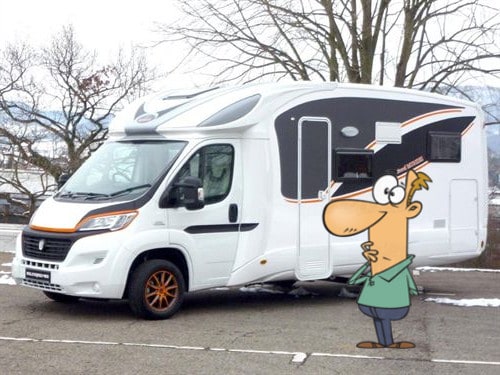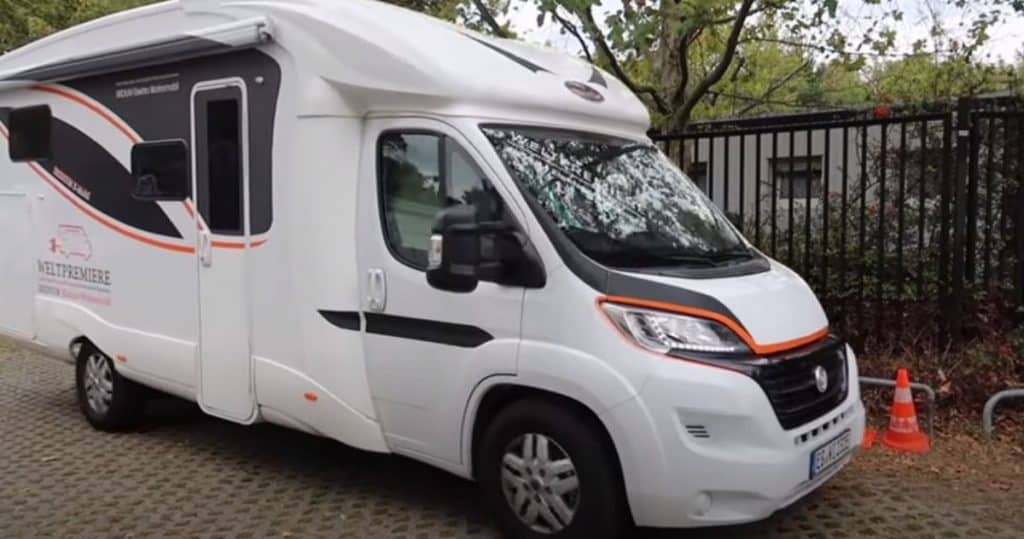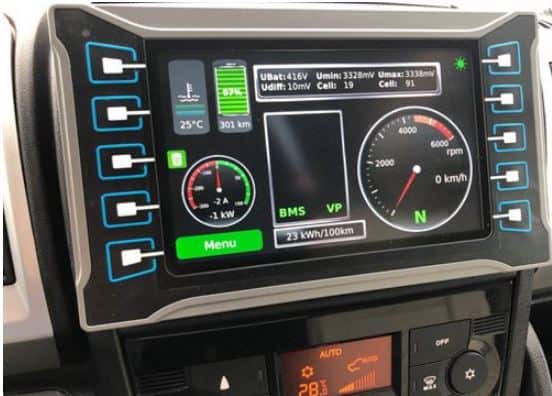
I recently wrote a post on motorhome engine remaps. Through that process, you can potentially achieve not only more power but also improved MPG. However, in reality, the future for diesel engines in motorhomes and most other vehicles will be coming to an end.
Not in the next couple of years but within a decade, I think emissions regulations are going to put most diesel-based vehicles off the road. Particularly within cities and towns (high-density population zones). Keeping up to date on electric tow cars is a little hobby of mine.
Our family owns an electric car (Nissan Leaf), but at some point, we do want to upgrade our diesel tow car to an electric tow car. But what about motorhomes? Are there any manufacturers today offering an electric motorhome? Well, it turns out there is one available now.

Now, I know people have a lot of concerns about electric vehicles. Hence there will be concerns about the concept of an electric motorhome.
The important point to remember with all the associated technology, batteries, charging network etc is that it is constantly developing.
Many aspects of owning and running an electric car/motorhome are not ready for mass adoption. But you can’t get to where you’re going without starting the journey.
Most electric cars currently are too expensive for your average consumer. Their range doesn’t meet everyone’s requirements, and charging rates vary considerably based on the specific vehicle and network infrastructure.
While my family is an early adopter of electric cars, I don’t preach to others that its right for everyone else (yet).
With this post on one of the first electric motorhomes, while it is available for purchase, I’m not implying it’s ready for the mass market.
But its important to recognise the effort/risk this company and its customers are taking to develop this technology, so there are affordable electric motorhomes in the future.
Disclaimer: Hey! By the way… any links on this page that lead to products on Amazon or Caravan Guard are affiliate links, and I earn a commission if you make a purchase, with no additional cost to you 🙂
- Dissolves waste and removes odours naturally and has delightful mild fragrance
Want To Visit Horton Common? – Book Here
Table of Contents
Introduction To Electric Motorhomes
The concept of an electric motorhome has always been something I knew we would see sooner or later.
However, until the other day, when I found the video below from Andrew Ditton, I wasn’t aware that a company was actually ready to bring one to market.
The company is called Iridium, and the model in question is the E Mobil electric motorhome. Now, this electric motorhome is only for sale in Germany currently and its a very niche enterprise.
Not only due to the price (more on that below), but they also don’t offer a right-hand-drive version as yet either.

As Andrew explains in the video, Iridium starts with a Mooveo motorhome and takes out the diesel engine, gearbox etc and replaces them with an electric motor and battery pack.
Now, I cannot currently find information on the layout of the battery pack.
Generally, with electric cars, they are often based on the ‘skateboard’ layout. Hence, the batteries are positioned between the two axles low down.
This provides the best utilisation of space, along with good handling. In this case, as its technically a conversation of an existing motorhome, I’m not sure what approach they have taken with the battery pack.
Power Output Of The Iridium E Mobile Electric Motorhome
From personal experience of driving even a modest electric car, the instant torque and hence acceleration are impressive.
Therefore, with an electric motorhome, yes, its heavy (more on that below), but it still has the torque to beat every diesel motorhome off the line.
The electric motors in the Iridium e Mobile provide 700nm of torque! To someone whos not into cars, that figure will mean nothing.
Therefore, I’ll give you a comparison. That’s exactly the same amount of torque you get from the current 5.0 V8 Range Rover at £142,000.
I’m not suggesting you want to go racing in an electric motorhome. However, that amount of torque makes driving up even the steepest hills and breeze. Provided you have sufficient charge, obviously.
Range Of The Iridium E Mobile Electric Motorhome
So from Andrew’s video above, you can see the first generation E Mobile came with an 86.4kW battery pack, and the second generation comes with a 108kW battery pack.
Andrew states that the manufacturers have told him the E Mobile electric motorhome will cover 400km (248 miles).
That would be the ‘potential’ range of the 108kW battery pack. Other media outlets are reporting the first generation E Mobile electric motorhome with 120 miles and 180 miles of range.

Real World Range In An Electric Motorhome
Now, speaking from experience here, the real-world range depends on a lot of factors. Whether you are going up and down hills and the outside temperature make a big difference to the range.
Going up a hill, you will be using more energy than you would be driving along a flat road (obviously).
Now, going down the hill, you will get some of that power back (regenerative braking). But its not a 1:1 ratio, in other words, you won’t get all of that additional power it took you to get up the hill back.
Furthermore, if its cold and you need the heaters on, that reduces your range. If its warm and you need the air con on, that reduces your range.
The second big consideration is weight. Its not clear how Iridium did its range tests. Was is with an unladen motorhome and just the driver (3,640kg)?
Or did they test the range at its maxed-out weight MTPLM (including belongings) at 4,000kg? Weight, as with any vehicle, affects efficiency and hence range.
My point is there are a lot of factors that will impact the range of an electric motorhome. It may achieve 248 miles, but I would predict that’s based on a lot of favourable conditions.
The Weight Of An Electric Motorhome
The Iridium Mobile E has an unladen weight of 3,640kg and a laden MTPLM weight of 4,000kg. Therefore, what this means is unless you passed your driving test before 1997 or you have passed your B+E driving test, you will not legally be able to drive this motorhome.
Anyone who does just have a category B driving licence may want to look into passing their B+E in the future if they want to be driving an electric motorhome.
Now, will modest-sized electric motorhomes such as the Mobile E always be this heavy? No, battery technology is constantly evolving and improving.
Battery energy density continues to improve. Within the last decade, the same-sized lithium battery now holds twice the energy of a battery of its equivalent size and weight from a decade ago.
So in the future, expect a battery pack that can provide this same amount of range (or more) to be considerably lighter. How long that will take though is obviously unknown.
Charging The Iridium E Mobile Electric Motorhome
So the Iridium E Mobile electric motorhome can charge via a 230V, 13A socket and either a 22kW AC or 50kW DC fast charger.
Now, because I’m a bit of an electric car nerd, I would have hoped for £150,000, they would future-proof their electric motorhome with the latest fast-charging tech.
In my electric tow car post, you can see that the likes of Tesla, Audi and Mercedes are fast charging 100kW+, and 350kW fast chargers are now being installed.
However, this electric motorhome can only charge at a maxium of 50kW, which is a bit disappointing and limits its viability.
Charging Times For The Iridium E Mobile
Ok, so let’s look at the worst-case scenario, charging from pretty much a flat to a full battery on a 16A site pitch. Well, for the 86.4kW battery pack, that would take around 23 hours.
For the 108kW battery pack, it would be closer to 29 hours. That’s based on a fairly simple calculation of dividing the battery capacity by the maxium amount of power 16A can provide (3.7kw).
Using the same basic calculation for a 22kW AC fast charger, it would be around 4 hours and 5 hours, respectively.
For a 50kW DC fast charger, it would be between 1.5/2 hours and between 2/2.5 hours, respectively. However, when it comes to fast charging, its not that simple.
Charge throttling is a real thing. In other words, the electric motorhome would not be charging at 50kW from 0% to 100%. Up to 50% state of charge, you may be getting close to a charge rate 50Kw.
However, after 50%, the charge rate will drop, hence taking longer to charge. Its due to battery protection measures, not wanting to put too much strain on the battery etc.
The Price Of The Iridium E Mobile Electric Motorhome
So what’s the damage? Well, customers in Germany will currently have to pay €169,000 (£150,500) for the E Mobile. Now, that’s obviously a lot of money, and only a very few people could afford it.
Some will then be thinking, but even if they could afford it, they could get a much bigger/better motorhome for that price!
Of course, you could, but that’s not really the point is it. I salute those early adopters who are willing to purchase a small electric motorhome for £150,000.
They are clearly making that decision on an emotional and principled basis. What their purchase will do is help to fund the development of better and cheaper electric motorhomes of the future.
Conclusions On The Iridium E Mobile Electric Motorhome
So at the start of this post, under the image, I posted a question is the E Mobile viable?
Well, after reading the above, it should be pretty clear anyone purchasing this electric motorhome is currently doing so on their beliefs and principles alone.
In other words, they are willing to put their money where their mouth is and not produce the associated emissions it usually involves when enjoying the motorhome life.
Now, how the electricity was produced to power the motorhome (coal, gas, nuclear or renewables) is another discussion. But in principle, an electric motorhome can be a much cleaner and more responsible way to enjoy using a motorhome.
I’ll admit as an electric car enthusiast and a small site owner, I’m a bit conflicted. I do want to see more electric cars and motorhomes on the road.
At the same time, the potential electricity bill for Horton Common when they do arrive scares me. I’m a planner though, figuratively and literally.
So I’m looking at how to update Horton Common in the future to deal with this issue and provide a fair pitch fee to our guests.
Anyway, I hope you found this post interesting. As I say, electric motorhomes are coming, just not yet for most of us.
I also hope you consider coming to visit us here at Horton Common in the near future to experience our fully serviced pitches. 🙂
Want To Visit Horton Common? – Book Here

